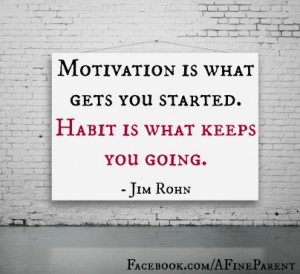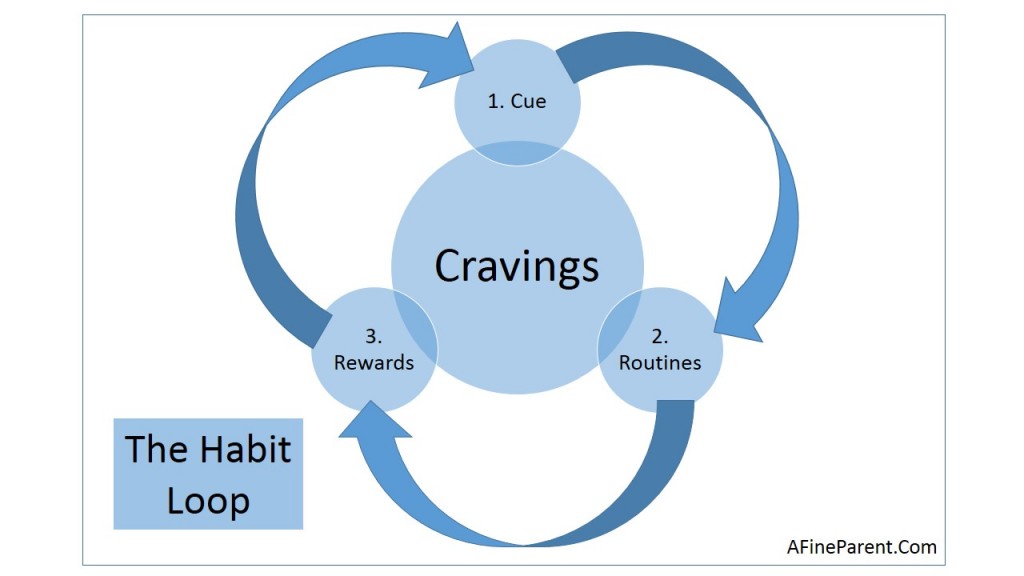(This article is part of our series on Habits.)
 Michael was a restless and hyperactive kid. One of his elementary school teachers impatiently complained to his mom
Michael was a restless and hyperactive kid. One of his elementary school teachers impatiently complained to his mom – “I just don’t ever see him being able to focus on anything in his life”. In 6th grade, he was diagnosed with Attention-Deficit Hyperactivity Disorder (ADHD).
And yet, today we know him as the Michael Phelps – the most decorated, legendary Olympian of all times who has to his credit 18 gold medals (twice as many as the next highest gold medal holder!), 2 silver medals and 2 bronze medals.
Ever wonder how Michael may have gone from a hyperactive kid to a laser focused Olympic gold winning phenomenon? You should. In his super achievements, lies a simple secret… the secret that can help us eliminate the biggest headache of parents around the world – power struggles!
The Secret
In his New York Times #1 bestselling book The Power of Habit: Why We Do What We Do in Life and Business, author Charles Duhigg explains that on the nights before his Olympic events, Michael would lull himself to sleep visualizing his “perfect race” – just as he did every night back at home.
Next morning he would wake up at 6:30am, the same time as every other day and have breakfast.
Later, exactly two hours before his competition, he would start his stretching routine, a regimen that he had worked through so many times before that his ankles were more flexible than that of a ballerinas.
Next, came the warm-up laps, a routine that lasted exactly 45 minutes.
And then it was time to gear up and head to the competition pool. There he would hook up the headphones to his ears and crank up the same hip-hop mix that he listened to before every competition since the age of 12.
 When his name was announced, he would step up on the block and then step down. He would swing his arms thrice, step back up on the block and get into stance and wait for the gun to fire indicating the start of the race – just as he did every time, no matter how big or small the race was.
When his name was announced, he would step up on the block and then step down. He would swing his arms thrice, step back up on the block and get into stance and wait for the gun to fire indicating the start of the race – just as he did every time, no matter how big or small the race was.
When the gun fired, he would leap into the pool and swim. Every minute of the routine until this point was well orchestrated and carried out to perfection. The race itself became an extension of the routine. There was no room for doubt, fear or any other form of distraction. Michael swam the perfect race he’d visualized. And in the process, he created history – again, and again.
Michael Phelps had found a secret that most of the athletes who go on to become legends, irrespective of the sport, rely on – on game day, you don’t think, you execute. You let the routine that you have spent years practicing to perfection, carry you to success.
So, What’s this Got to Do With Power Struggles With Our Kids?
Much of the power struggles we see arise because our kids brains tug them in two different directions. One part of their brain wants to follow the instructions because it is what they are “supposed to” do. But another part of the brain, just can’t help wanting to go in the opposite direction – it seems like more fun, it’s what their peers are doing, it’s easy, it’s less intimidating… whatever. It is what they “want” to do. And a conflict arises. As often happens in a tug of war involving will power, the “want” overpowers the “supposed to”, and the child starts to act out.
There are of course many different ways we can handle this situation gracefully as we have seen here, here or here.
But, what if we could avoid this tug of war entirely?
What if we could automate some of the repetitive tasks in such a way that our kids’ brains aren’t even burdened with choice/decision/worry — like Coach Bowmen helped Michael Phelps do?
Think about the morning rush to get out the door, dinner struggles, homework resistance, bedtime battles and so on. These are all repetitive tasks, but somehow they get out of control and repeatedly result in us nagging/screaming at our kids. Imagine just how many skirmishes we can avoid by establishing a “habit” of getting through them without giving them much thought.
If habits can help Michael Phelps, who was diagnosed with ADHD, channel his energy to win medals under high stress conditions, couldn’t they help us get out the door in the morning without resorting to screaming matches? Couldn’t they help us make mealtimes smooth and homework time less stressful?
All we need is to establish a few routines that take resistance out of the picture!
That’s just one piece of this puzzle though.
Before we move forward, we need to inspect another key piece – our own reaction to our kids when we notice that they are dawdling in the mornings or watching TV when they should be doing homework instead. In all probability, in these circumstances, we start nagging or screaming, or worse, both. Now pay attention to your own brain… if you look closely, you will notice that in most of these cases when you are nagging or screaming, you’re not really thinking at all. Your brain is not really engaged! In other words, often we nag or scream out of habit.
So the second piece of eliminating powers struggles is to break out of our own habit of nagging or screaming at our kids when our kids push our buttons.
Just as good habits have the power to propel us towards success, bad habits have the power to bring us down!
And these two together comprise of what we will look at through the rest of this month — (a) establishing some good habits for our kids and (b) breaking out of some of our own bad habits.
For today, let’s take a quick look at how habits work.
The Science of Habits
Consider this interesting experiment conducted by the neuroscientists at MIT for example. They placed a rat behind a barrier which opened with a loud click into a T-shaped maze. As the rat moved down the long arm of the maze and reached the decision point, they gave it an auditory cue at which the rat could choose to turn left or right. If the rat turned in the correct direction, it would receive a reward – chocolate milk or sucrose solution. If it went in the wrong direction, of course, there was no reward. At first the rats meandered slowly, sniffing the corners and scratching the walls not knowing what to do. Soon though, they started to get the hang of it, and eventually they perfected the T-maze task with ~90% accuracy.
And then, the sneaky scientists tainted the chocolate milk so it would make the rats nauseous. The rats soon developed an aversion for the reward. However, when the scientists put the rats in the maze and provided the auditory cue at the decision point, the rats still ran in the right direction, even though they would not drink the tainted chocolate milk. Running the maze and responding to the auditory cues in a particular way had become an ingrained habit, and the rats did it, even when the reward was no longer available!
Habits, Decoded
In the book The Power of Habit: Why We Do What We Do in Life and Business mentioned above, author Charles Duhigg explains the exact process our brain uses to automate the tasks with a 3-step cycle called the Habit Loop as shown below.
The first step of the habit loop is a cue or trigger that lets the brain know that this is a repetitive task that can be handled in an automatic mode, and check if there is a previously learned sequence i.e., a habit that can be used.
The second step is the routine, which is the execution of this sequence of tasks automatically.
The third step is the reward, or the benefit obtained by following this routine. If the reward is good, then the brain makes a note that this routine is worth automating and commits it into memory to be executed the next time it is encounters the same cue again.
The loop in itself does not result in a lasting habit. What makes habits stick is that the loop is repeated over and over, enough number of times, until it can be executed automatically without intervention from the thinking part of the brain. The critical part of the habit loop that makes this happen is the craving. Unless the reward is something that results in a craving which gets triggered the moment the brain encounters the cue, a habit is unlikely to stick.
Once the habit is stuck however, chances are, it will stay stuck even if the reward is removed.
Our Habits, Through The Lens of The Habit Loop
Let’s look at the example our nagging/screaming habit from the habit loop perspective.
First, one of our kids behaves in a manner that is against our wishes – that is the cue. This triggers in us the primitive cravings for gaining back control over the situation. We seek obedience and compliance. We launch the routine of nagging and screaming. This eventually gets our kids to comply – that is the reward. And since we were rewarded, and our cravings are satisfied, the habit loop is now committed into our memory to be repeated over and over.
Eventually, the routine may lose its effectiveness and the kids may not respond to nagging/screaming, or may just repeat the misbehavior again under slightly different circumstances. But just like the rats that run the T-maze even when the reward is no longer available, we continue to nag and scream, simply out of habit.
So, Ready for the Plan to Eliminate Power Struggles?
Here it is —
Step #1: Eliminate the cues that cause the habit loop by creating some good habits in our kids for repetitive situations.
Step #2: Modify our own routines when we do encounter the cues, so instead of nagging/screaming we do something more constructive that can offer more lasting results.
That’s it. Over the next two weeks we’ll look at each of these steps. If you’d haven’t already done so, sign up here to be notified when the article comes out.
The 2-Minute Action Plan for Fine Parents
For our reflection questions today pick the last time you had a power struggle or a screaming match in your family
- Was your response habitual or intentional?
- If it was out of habit, what would you have done differently if you had taken a couple of minutes to stop and think it through?
- What was the cue that triggered the incident?
- Is it a recurring incident? If yes, is there some habit or routine you can set in place to avoid this cue all together?
As always, if you feel up to it, I’d love for you to share your answers!
The Ongoing Action Plan for Fine Parents
As you go through the week, become aware of when an “incident” occurs and ask yourself the 2-minute reflection questions to see if there is a better way to proceed. The key for this week is to start putting together a list of cues that you want to eliminate in your family by establishing some good habits (we’ll look at how to establish the habits next week) and to identify some of your habitual responses that your want to break (we’ll look at how to do this the week after).
And as always, until then, keep doing the best you can, to be the best parent you can be!

Good evening !! I am another of 3 children and my elder boy always is not wanting to study and not want to do his homework and always I am fighting with him and even at school he is not in the same place and as days goes on he I’d now having low mark .what can I do I need help and guidance .thanks and have a nice evning
This is exactly what I have been trying to implement at our house for bedtime–it’s pretty much a nightly struggle despite the same “to-do” list every night of her life. I find that when I go off course–checking my email quickly, doing the last bit of dishes/laundry–she takes that as an opportunity to do her own thing. The reward has always been reading, and although we have slacked off with it the last 3 months or so, we’re getting back into it now.
I think it’s just what makes any habit stick and become part of you so you don’t miss it–routine, consistency and discipline.
Bernadette!!! Hi 🙂 Yes, it’s the staying consistent that is the toughest part of this whole habit/routine creation thing for me as well. Hang in there… you will be back in the groove in no time!
Hi Sumitha, this is a great article and it came at the correct time, especially since I am having daily struggles with my 5-year old daughter who refuses to go to school. Scolding & nagging has become a daily habit for me and I really do not want to be a nagging mother. I get tired of hearing my own voice! Gosh, I can’t wait for your upcoming articles especially on how to break this habit, I just want to break this habit of mine and have stress-free mornings. 🙂
Hi Prema, Thank you so much for sharing that. When I started turning things around in my home, changing the morning routine was the first one I tackled! It took me a while to get a handle on it… once I got that under control though, it so much easier to get other things under control (TV watching, homework, toy cleanup etc.). I’ll use the morning routine as the example of next week’s article… hopefully it will help you establish stress-free morning rather quickly and move on to enjoying life a whole lot more! 🙂
Yes Thank you thank you thank you! The dinner, bath, bed thing regularly involves me screaming my head off at my kids (“We do this every night, why do I always end up having to yell at you??!”). To no avail. I’d love to learn how to change this!! Ah Sumitha, you are truly a wonderful friend in need! Again!
By the way I really really enjoyed last months topic of mindset. I am working constantly on it. Thanks.
It’s so great to read such an enthusiastic response the first thing in the morning… you just made my day, Cleo! 🙂
“We do this every night, why do I always end up having to yell at you??!” — Gosh, I know exactly what you mean! For us the biggest contention was mornings…. I thought I wasn’t a “morning person” and suspected that it was the same with my daughter and that’s why we had all that drama day after day. I was resigned to mornings with screaming matches for the rest of our lives until I started to see things from this alternate perspective. Things are so much smoother these days and it feels so good to start the day off on the right foot…. When I look back now, I don’t see how/why we screamed so much at each other 🙂 Hang in there… it may take some time, but it’s so, so, so worth the effort!